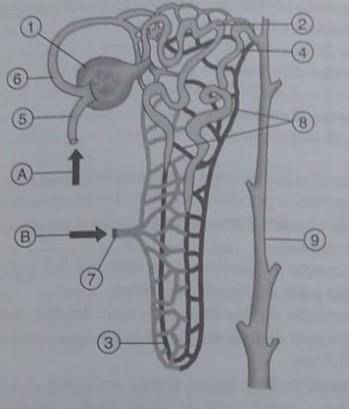
Biology, 26.03.2021 16:50 maribelsalgado3
BIOLOGIA - Questões acerca do desenho:
61. Onde se localiza, no rim, a estrutura indicada por (1) no desenho?
62. Que processos importantes para a função renal ocorrem na estrutura indicada por (1)?
63. Qual é a principal diferença, quanto à composição química, entre o sangue que circula em (A) e o sangue que circula em (B)? Explique o porquê da diferença.
64. Qual é a principal diferença, quanto à composição química, entre o fluido contido em (1) e o fluido que circula em (9)? Explique o porquê da diferença e dê os nomes desses fluidos.
65. Um dos efeitos no organismo do hormônio adrenalina é causar a contração e consequente estreitamento de (6). Deduza os possíveis efeitos que uma descarga de adrenalina no sangue de uma pessoa poderia causar, na filtração renal e na quantidade de urina formada.


Answers: 1


Another question on Biology

Biology, 22.06.2019 02:30
Apaleontologist finds a plant fossil that shows that the plant had seeds. what can the paleontologist conclude?
Answers: 1

Biology, 22.06.2019 06:00
Which kingdom includes some organisms that have no nucleus and can live in an environment with an extremely high salt content
Answers: 1


Biology, 22.06.2019 06:50
The kidney filters potentially toxic substances in the blood, and thus “clears” the blood of those substances. this clearance function is dependent upon and proportional to the diffusion gradient of the substance across filtering capillaries, i.e. if the concentration of the substance is doubled, twice as much will be cleared from each ml of blood that is filtered. suppose that the body produces a constant amount of a substance x per unit of time. the kidneys eliminate substance x at a rate directly proportional to the concentration of the substance and the volume of blood cleared each minute (c): elimination = c × [x], where [x] is the steady-state concentration of substance x. imagine an individual with an initial concentration of x equal to [x]0 who develops kidney disease. her baseline clearance c0 drops to one half of the original (½c0). what is the new steady state concentration of x? (for simplicity, assume that substance x is 100% filtered by the kidney).
Answers: 1
You know the right answer?
BIOLOGIA - Questões acerca do desenho:
61. Onde se localiza, no rim, a estrutura indicada por (1) n...
Questions

Mathematics, 02.12.2020 21:30

History, 02.12.2020 21:30

Chemistry, 02.12.2020 21:30





Physics, 02.12.2020 21:30


Mathematics, 02.12.2020 21:30

Mathematics, 02.12.2020 21:30


Mathematics, 02.12.2020 21:30





Mathematics, 02.12.2020 21:30


Mathematics, 02.12.2020 21:30



